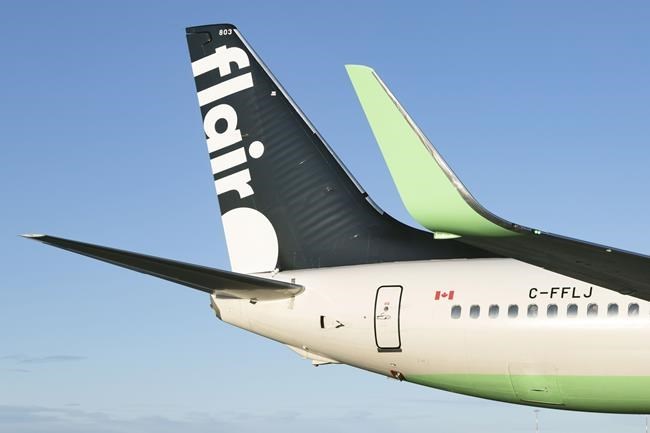In the face of a North American pilot shortage, Canadian discount carrier Flair Airlines is launching a unique training program that will fast-track candidates into the cockpits of the company's jets.
The Edmonton-based carrier says its new airline pilot training program, which will be offered in partnership with Genesis Flight College in Collingwood, Ont., will radically speed up the length of time it takes in sa���ʴ�ý for new pilots to get jobs flying large commercial jets.
Candidates will enter the program with no previous flying experience and 18 months later will qualify to become first officers on Flair Airlines' fleet of Boeing 737 MAX aircraft, the company said Thursday.
"What we’re doing with this is really preparing for our future growth, because ... if you take a longer-term industry outlook, there’s a big (pilot) shortage coming," said Flair CEO Stephen Jones in an interview.
A pilot shortage has been brewing across the continent for several years due to a variety of factors including an aging workforce and the rapid proliferation of new discount airlines that are putting pressure on the labour supply. (One of these discount airlines is Flair itself, which had just three aircraft at the start of 2021 but has expanded to a fleet of 21 Boeing 737s, offering service to over 30 cities across sa���ʴ�ý, the U.S. and Mexico.)
But the COVID-19 pandemic exacerbated airlines' already existing labour challenges, delaying and disrupting pilot training across the country while also driving experienced pilots to exit the industry in favour of more job stability elsewhere.
International consultancy firm Oliver Wyman has estimated that the North American aviation industry could be short 30,000 pilots by 2032 if nothing changes.
"What that means, in my opinion, is it's the perfect time to introduce a program where we do targeted training to train exactly what we want, how we want, to get the quality that we want for our pilots," said Grey Cooper, manager of pilot training at Flair.
"It's the perfect timing for sa���ʴ�ý to step into the 21st century, actually."
While Transport sa���ʴ�ý regulations require a candidate to have at least 250 hours of flying time to qualify for an airline transport pilot license, traditionally, most pilots being hired by major airlines have had far more than that.
In fact, Cooper said commercial pilots often spent years flying small planes on regional and northern routes before ever graduating to big jets.
"There was more supply than demand for airline pilots. You could end up sitting on a smaller airplane for multiple years before you got the opportunity," he said.
But as pilots become harder and harder to come by, airlines have begun hiring people with less experience — as little as two years flying smaller planes now as opposed to the five or 10 it used to take to get hired as an airline jet pilot, Cooper said.
He added Flair's program meets all of Transport sa���ʴ�ý's regulatory requirements and will adhere to the highest industry standards for training and safety. In addition to pre-screening applicants for aptitude and competence before they ever enter the program, Flair has also partnered with technology company CTS Aero to incorporate state-of-the-art virtual reality tools and flight simulators into the program, Cooper said.
While Flair is the first to pioneer the concept in sa���ʴ�ý, Cooper said European airlines have many programs that take people with no experience and equip them to get jobs on Boeing 737 and Airbus A320 jets immediately upon completion.
"We're taking proven systems that have worked worldwide and are applying them to sa���ʴ�ý," he said.
Flair said it will accept its first cohort of 10 aspiring pilots in January 2024.
Students accepted into the program will receive a conditional offer of employment with the airline and transition directly into the airline upon graduation.
This report by The Canadian Press was first published Aug. 17, 2023.
Amanda Stephenson, The Canadian Press



